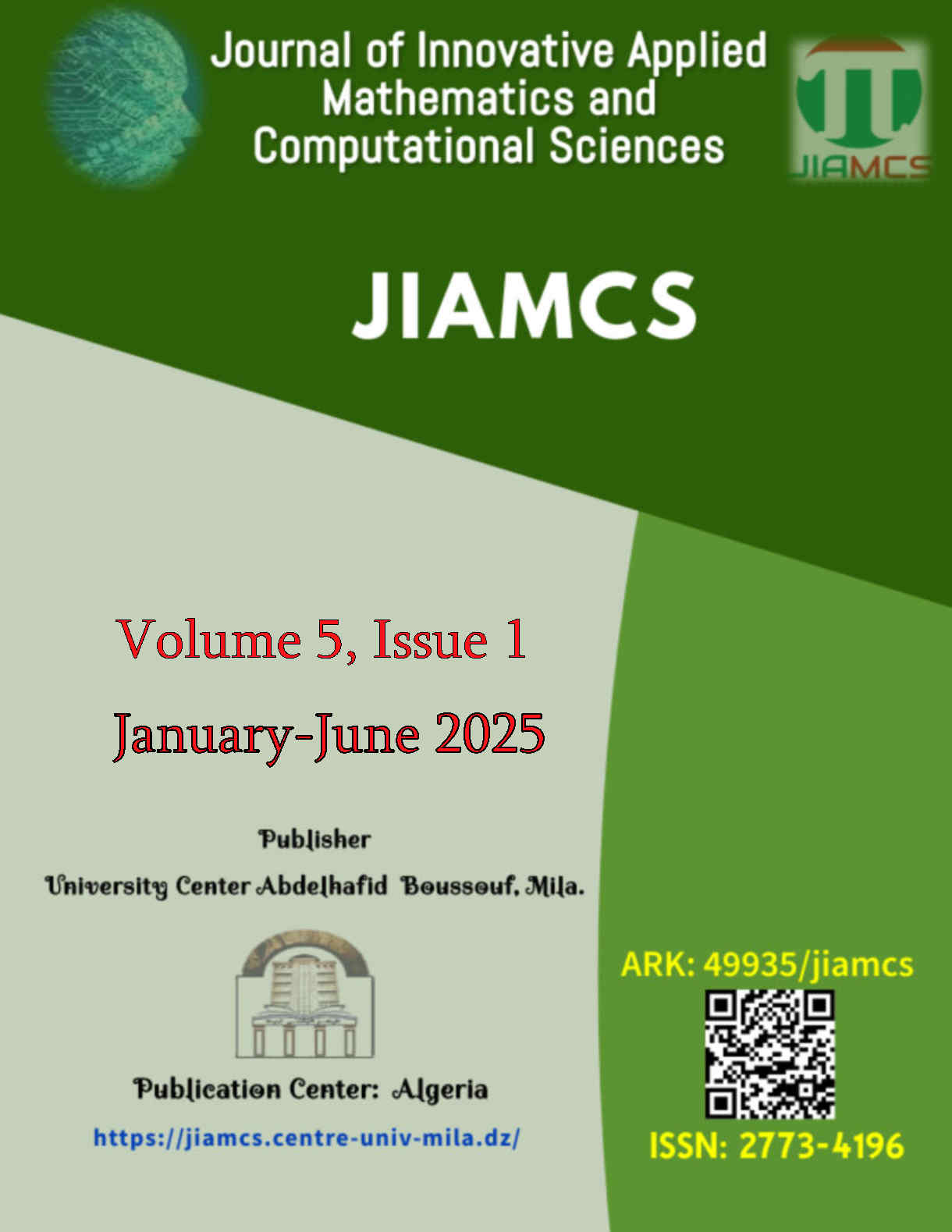Stability and sensitivity analysis of an infectious respiratory disease with vaccination and use of face masks
Main Article Content
Abstract
Mathematical modeling serves as a vital tool in public health, enabling policymakers to synthesize evidence, forecast disease trends, and assess intervention strategies. This study investigated the combined effects of face masks, quarantine, social distancing, and vaccination in controlling infectious respiratory diseases. The reproduction number was derived using the next-generation matrix (NGM). Local stability analysis utilized the Gershgorin Circle Theorem, while global stability was analyzed through the Quadratic Lyapunov Theorem. Sensitivity analysis was conducted using the normalized forward sensitivity index, and numerical simulations were performed with Python libraries such as \textit{scipy, numpy}, and \textit{matplotlib.pyplot}. Bifurcation analysis was carried out using the Center Manifold Theorem. The findings revealed that while these measures effectively reduced infection spread, they were insufficient to completely eliminate disease transmission. This study underscores the importance of implementing multiple strategies concurrently to effectively control the transmission of infectious diseases and guide public health interventions.
Downloads
Article Details

This work is licensed under a Creative Commons Attribution-NonCommercial-NoDerivatives 4.0 International License.
- Authors keep the rights and guarantee the Journal of Innovative Applied Mathematics and Computational Sciences the right to be the first publication of the document, licensed under a Creative Commons Attribution-NonCommercial-NoDerivatives 4.0 International License that allows others to share the work with an acknowledgement of authorship and publication in the journal.
- Authors are allowed and encouraged to spread their work through electronic means using personal or institutional websites (institutional open archives, personal websites or professional and academic networks profiles) once the text has been published.
References
[1] M. O. Adeniyi, M. I. Ekum, C. Iluno, and S. I. Oke, Dynamic model of COVID-19 disease with exploratory data analysis, Scientific African, 9 (2020), e00477.
[2] A. A. Alimi and A. A. Ayoade, Mathematical modeling of the effect of vaccination on the dynamics of infectious diseases, Nepal Journal of Mathematical Sciences, 4(1) (2023), 1–10.
[3] A. S. Alsheri, A. A. Alraeza, and M. R. Afia, Mathematical modeling of the effect of quarantine rate on controlling the infection of COVID-19 in the population of Saudi Arabia, Alexandria Engineering Journal, 61(9) (2022), 6843–6850.
[4] G. Birkhoff and G. C. Rota, Ordinary Differential Equations, Blaisdell Pub. Co., Waltham, Mass, 1969.
[5] V. Bitsouni, N. Gialelis, and I. G. Stratis, A model for the outbreak of COVID-19: Vaccine effectiveness in a case study of Italy, arXiv preprint arXiv:2008.00828, 2020.
[6] B. Buonomo and C. Vargas-De-León, Stability and bifurcation analysis of a vector-bias model of malaria transmission, Mathematical Biosciences and Engineering, 242(1) (2013), 59–67. https://doi.org/10.1016/j.mbs.2012.12.001
[7] C. Castillo-Chavez and B. Song, Dynamical models of tuberculosis and their applications, Mathematical Biosciences and Engineering, 1(2) (2004), 361–404. https://doi.org/10.3934/mbe.2004.1.361
[8] K. H. Chan and K.-Y. Yuen, COVID-19 epidemic: disentangling the re-emerging controversy about medical facemasks from an epidemiological perspective, International Journal of Epidemiology, 49(4) (2020), 1063–1066.
[9] N. Chitnis, J. M. Hyman, and J. M. Cushing, Determining important parameters in the spread of malaria through the sensitivity analysis of a mathematical model, Bulletin of Mathematical Biology, 70(5) (2008), 1272–1296.
[10] C. Connelly, Epidemiology Through the Lens of Differential Equations, 2023.
[11] S. E. Eikenberry, M. Mancuso, E. Iboi, T. Phan, K. Eikenberry, Y. Kuang, E. Kostelich, and A. B. Gumel, To mask or not to mask: Modeling the potential for face mask use by the general public to curtail the COVID-19 pandemic, Infectious Disease Modelling, 6(1) (2020), 293–308.
[12] N. K. Geofrey, M. Harun, M. Samuel, and N. Edward, A Mathematical Model to Investigate How Vaccination Affect the Reproduction Number for COVID-19, International Journal of Systems Science and Applied Mathematics, 9(2) (2024), 20–29. https://doi.org/10.11648/j.ijssam.20240902.11
[13] Y. Gu, S. Ullah, M. A. Khan, M. Y. Alshahrani, M. Abohassan, and M. B. Riaz, Mathematical modeling and stability analysis of the COVID-19 with quarantine and isolation, Results in Physics, 34 (2022), 105284.
[14] I. U. Haq, N. Ullah, N. Ali, and K. S. Nisar, A new mathematical model of COVID-19 with quarantine and vaccination, Mathematics, 11(1) (2022), 142.
[15] L. P. James, J. A. Salomon, C. O. Buckee, and N. A. Menzies, The use and misuse of mathematical modeling for infectious disease policymaking: lessons for the COVID-19 pandemic, Medical Decision Making, 41(4) (2021), 379–385. https://doi.org/10.1007/s11071-011-0263-4
[16] Q. Li, X. Guan, P. Wu, X. Wang, L. Zhou, Y. Tong, ... and Z. Feng, Early transmission dynamics in Wuhan, China, of novel coronavirus–infected pneumonia, New England Journal of Medicine, 382(13) (2020), 1199–1207.
[17] C. R. MacIntyre and A. A. Chughtai, Facemasks for the prevention of infection in healthcare and community settings, BMJ, 350 (2015).
[18] S. Mandal, N. Arinaminpathy, B. Bhargava, and S. Panda, Plausibility of a third wave of COVID-19 in India: a mathematical modelling based analysis, The Indian Journal of Medical Research, 153(5–6) (2021), 522.
[19] N. Nuraini, K. K. Sukandar, P. Hadisoemarto, H. Susanto, A. I. Hasan, and N. Sumarti, Mathematical models for assessing vaccination scenarios in several provinces in Indonesia, Infectious Disease Modelling, 6 (2021), 1236–1258. https://doi.org/10.1016/j.idm.2021.09.002
[20] J. N. Paul, I. S. Mbalawata, S. S. Mirau, and L. Masandawa, Mathematical modeling of vaccination as a control measure of stress to fight COVID-19 infections, Chaos, Solitons and Fractals, 166 (2023), 112920.
[21] C. Rattanakul and I. Chaiya, A mathematical model for predicting and controlling COVID-19 transmission with impulsive vaccination, AIMS Mathematics, 9(4) (2024), 6281–6304.
[22] H. M. Wanjala, Mathematical Modelling of SARS-CoV-2 Incorporating Non-Pharmaceutical Interventions Coupled with Vaccination, Masters thesis, Chuka University, 2023. https://doi.org/10.13140/RG.2.2.35446.78405
[23] H. M. Wanjala, M. O. Okongo, and J. O. Ochwach, Impact of Media Awareness and Use of Face-Masks on Infectious Respiratory Disease, Pan-American Journal of Mathematics, 2 (2023), 15.
[24] H. M. Wanjala, M. O. Okongo, and J. O. Ochwach, Mathematical Model of the Impact of Home-Based Care on Contagious Respiratory Illness Under Optimal Conditions, Jambura Journal of Biomath, 5(2) (2024), 83–94. https://doi.org/10.37905/jjbm.v5i2.27611




